2025 LSAMP SCHOLARS

Portable LiDAR System for 3D Mapping: Assembling, Data Collection, and Visualization
Abdullah Abadi, Computer Information Systems
Buffalo State University
Faculty Mentor: Dr. Tao Tang
To create virtual reality models in a computational environment, it is essential to collect three-dimensional (3D) data from the real world. LiDAR, a key technology in remote sensing, is commonly used for this purpose. In this study, we acquired a LiDAR scanner and integrated it with computer hardware and software, GPS (Global Positioning System), and a portable power supply to develop a mobile LiDAR system for digital data collection. After assembling and testing the system, we used it to scan the Technology Building and the Science and Mathematics Complex (SAMC), also capturing color images of the building walls and roofs. The primary objective of this work is to build an accurate, scalable virtual reality model in a computational environment.
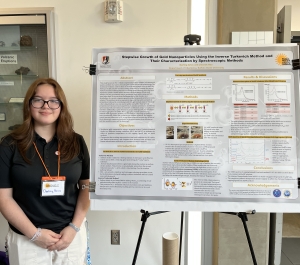
Stepwise Growth of Gold Nanoparticles Using the Inverse Turkevich Method and Their Characterization by Spectroscopic Methods
Darling Arias, Forensic Chemistry
Buffalo State University
Faculty Mentor: Dr. Jinseok Heo
This study focuses on the synthesis of gold nanoparticles (AuNPs) of commercial quality and their characterization using UV-visible and Raman spectroscopy. The traditional Turkevich method relies on the reduction of Au(III) ions to Au(0) by boiling an Au(III) solution and then adding citrate ions. In contrast, the inverse Turkevich method adds Au(III) ions to a boiling citrate solution, which has been reported to produce AuNPs with a narrower size distribution. While small AuNPs (<20 nm) are relatively easy to synthesize, those with average particle sizes larger than 50 nm are more challenging due to their broader size distribution. As a result, a stepwise growth method using seed particles is widely adopted. The synthesis involves sequential stages, starting with seed particle preparation, followed by controlled growth through multiple steps. In this study, a four-step growth process was used to synthesize AuNPs. Their spectral properties were characterized using UV-Vis absorption spectroscopy and Raman spectroscopy, with and without micromembrane filtration using a 0.22 μm pore size filter. Additionally, a quick-freezing technique with liquid N₂ was employed to induce aggregation of AuNPs. These aggregates, termed quick freezing-induced AuNP aggregates (QFIAAs), are essential for comparing the quality of in-house synthesized AuNPs with commercially available products. The analysis reveals spectral differences in UV-Vis and Raman spectra between the QFIAAs of the in-house and commercial products. In this presentation, these differences and their possible causes will be discussed.
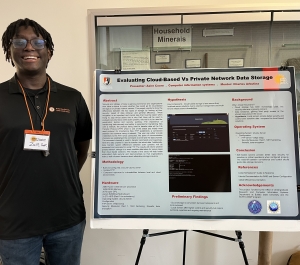
Evaluating Cloud-Based vs Private Network Data Storage
Zaire Coore, Computer Information Systems
Buffalo State University
Faculty Mentor: Prof. Charles Arbutina
Security and storage of data is gaining prominence and organizations now have a choice to make, whether they would go for cloud-based storage or for private network servers. This project intends to show the differences between the two types of storage by looking at their security, speed of data retrieval, and general efficiency. Threat mitigation is an important and crucial step that must be taken when trying to stop threat actors this is why Kali Linux will be used to evaluate security flaws within both systems, this tool is to be used for penetration testing and security auditing. The importance of transferring data securely and safety is essential for transferring files over a network, the protocol being used to transfer data will be File Transfer Protocol (FTP) which is one of the oldest and widely most used protocol for transferring files. FTP establishes a connection between two systems using a network. The user can either provide credentials to the FTP. Once connected, two types of communication channels are established: the command channel and the data channel. The command channel is used to transfer commands and responses, while the data channel is used to transfer the actual data. Additionally, data transfer speed differences between both systems will be measured and compared to using FTP. The results will inform whether private network storage is a more credible alternative for some cases than cloud-based solutions. The results of this study will help better understand data security and so organizations make a well-informed decision.

Screening Heterocyclic Compounds Against Triple-Negative-Breast-Cancer (TNBC)
Nicole DelliColli, Forensic Chemistry
Buffalo State University
Faculty Mentor: Dr. Jinseok Heo
Triple-negative breast cancer (TNBC) is a highly aggressive subtype of breast cancer that lacks expression of receptors such as estrogen, progesterone, and HER2. Treatment of TNBC is often challenging due to poor prognosis, high recurrence rates, and its resistance to many available therapies. Heterocyclic molecules with diverse scaffolds are known to interact with various biological targets and are emerging candidates that can offer effective treatments for TNBC with high potency and specificity. These molecules are known to modulate the proteins involved in critical signaling pathways that regulate cell cycles, apoptosis, and angiogenesis. An aberration of such a cellular process triggers tumor formation and cancer. Heterocyclic-based molecules are known to demonstrate anti-TNBC activity through mechanisms such as DNA intercalation, kinase inhibition, and immune modulation. In this project, we studied the cytotoxicity of the structurally and functionally diverse heterocyclic molecules created through cross-coupling reactions using MTT/AlamarBlue assay. Through this approach, we have identified a few hit molecules that can be further diversified into a lead through a structural-activity relationship (SAR).

Giant Anomalous and Topological Hall Conductivity in a Ge substituted HoMn6Sn6 Kagome single crystal
Jemma DeFeo, Physics
Buffalo State University
Faculty Mentor: Dr. Dan MacIsaac
How does cadmium telluride (CdTe) and perovskite photovoltaics (PV) compare to traditional crystalline silicon (c-Si) in terms of efficiency, scalability, and stability? Due to concerns on climate change, the global demand for renewable energy has been rising every year. Researchers have been working on more efficient and costeffective solar technologies to meet these needs. While c-Si has been the industry standard, alternatives like CdTe and perovskite offer the potential for higher efficiency and easier manufacturing. This project focuses on recent developments of CdTe and perovskite photovoltaics. Basic research on specific fields includes trends in efficiency, scalability potential, and overall technological progress. A further analysis of economic viability and aspects of ethical, legal and social implications (ELSI) is also conducted. Cdte and perovskite PVs are then compared to c-Si as the baseline and ranked based on their performance in these areas. The study also explores how machine learning can further enhance next-generation PVs. The goal of this research is to assess how CdTe and perovskite photovoltaics have evolved in recent years and to determine whether they have a clear path to surpassing silicon in commercial solar applications.

Avian Foraging Behavior Does Not Differ Depending on the Type of Observation
Jennifer Eweka, Chemistry
Buffalo State University
Faculty Mentor: Dr. Gavin Leighton
My study aimed to investigate whether the presence of a human observer influences avian interactions at a foraging resource in comparison to observations conducted using a trail camera. The hypothesis was that the presence of a human observer (sufficiently far away) would not significantly alter the behavior and interactions of the birds at the feeders. Two types of trials were employed to test my hypothesis. The first involved a human present to observe the avian interactions and the other utilizing a trail camera to record avian behavior without an observer present. I collected data on Buffalo State’s campus and other locations and analyzed the data using several linear mixed models. These models tested various dependent variables related to avian behavior, including the number of individuals visiting the feeder, the diversity of species present, and the timing of the earliest arrival at the feeder. As predicted, there were no major significant differences in avian behavior between in-person and video trails across the variables I collected. Thus, trail cameras represent a potential method for recording animal behavior.
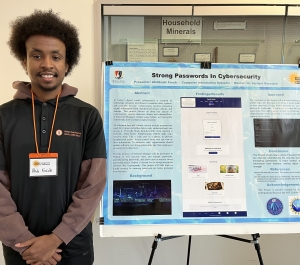
Strong Passwords In Cybersecurity
Abdikadir Farah, Computer Information Systems
Buffalo State University
Faculty Mentor: Dr. Sarbani Banerjee
In today’s digital world, cybersecurity is essential as technology advances and threats to sensitive data, systems, and networks increase. Cybersecurity involves protecting digital information from unauthorized access, attacks, and damage. This project focuses on three key aspects of cybersecurity: security measures, threats, and vulnerabilities. A Password Manager, developed as a website using HTML and CSS, will practically demonstrate how to enhance digital security. To safeguard data and systems, several security measures are used. Encryption scrambles data so only authorized users can access it. Firewalls block harmful traffic from entering a network. Multi-Factor Authentication (MFA) adds extra security steps, like a code sent to a phone, to prevent unauthorized access. Access control limits who can view or alter information. To minimize risks, organizations should update software, use strong passwords, and train employees on security best practices. For this project, a website-based Password Manager will be developed using HTML and CSS. The site will securely store user data, including name, password, security code, and security questions, ensuring sensitive information is well-protected. The website will include features for generating strong passwords and securely retrieving stored credentials. The focus will be on creating an interface that ensures password protection through careful design and security measures. This project will help improve digital security by providing a user-friendly platform for safely managing passwords, preventing unauthorized access, and enhancing overall cybersecurity.
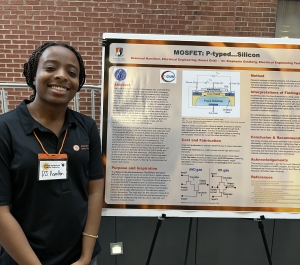
MOSFET: P-typed...Silicon
Diamond Hamilton, Electrical Engineering Technology
Buffalo State University
Faculty Mentor: Dr. Stephanie Goldberg
The current research study will dive deeper into understanding the inner workings of logic circuits as well as their packaging. The project is expected to show the mechanical and electrical makeup of the MOSFET transistor. Specifically, I will discover and discuss information regarding its materials’ conductivity, oxidation and its other aspects that prove its effectiveness. A MOSFET transistor is the most common type of transistor and is used to control the flow of electricity within the system. I will be researching by using the traditional method of reading articles and textbooks to gather knowledge as well as observing the transistor itself. I will be able to demonstrate these findings by recording them as I observe the usage of the transistor within a circuit in two different ways: one including the AND gate and one utilizing the OR-gate; which both are made with the MOSFET transistors from the CMOS family. The results and the investigative observations discovered during this project will explain how the components and materials used to produce the MOSFET transistors affect its functionality and effectiveness. This project will go in depth about the reasons why this type of transistor is so commonly used and more specifically, how these transistors are manufactured. The significance of this project goes beyond this generation’s prototypes and inventions. Alas, by using the concepts and technical information found in this study, future generations will be able to enhance the smart grid, improving the quality and speed of electrical tools and resources.
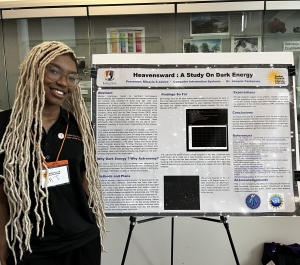
Heavensward: A Study on Dark Energy
Mikayla James, Computer Information Systems
Buffalo State University
Faculty Mentor: Dr. Joaquin Carbonara
Modern cosmology, fueled by significant technological advancements, has enabled us to explore and uncover phenomena we humans only dreamed of doing long ago. One such phenomenon is dark energy, a theorized and invisible force believed to be driving the accelerated expansion of the universe, pushing galaxies farther apart. This project aims to investigate the nature of dark energy and its crucial role in the expansion of the universe. Using data from the Dark Energy Survey (DES), which maps and measures the distribution of galaxies using 4 unique methods, I will examine two primary methods for studying dark energy: gravitational lensing and Type Ia supernovae. These techniques offer complementary insights into the rate of cosmic expansion, providing a more holistic understanding of dark energy’s influence. To measure this expansion, I will apply the Hubble constant (v = H₀D), a key formula that describes how far a cosmic entity, such as a galaxy, is moving away from Earth. By using this constant, I will calculate the rate of expansion, estimate the universe's growth over the years and possibly predict it’s future trajectory. For data analysis and presentation, I will utilize Python and Visual Studio Code alongside plugins like Pyarrow, Pandas and Conda for calculations, data manipulation and management, wwwmodeling, and visualization. These tools will help me simplify and communicate my findings clearly and possibly provide new insights on the ever-growing neighborhood we reside within.
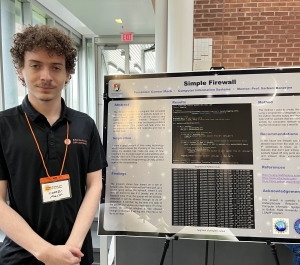
Simple Firewall
Connor Mack, Computer Information Systems
Buffalo State University
Faculty Mentor: Dr. Sarbani Banerjee
This project focuses on developing a dynamic firewall system to enhance network security by providing real-time monitoring, filtering, and logging of network traffic. Traditional firewall models often struggle to adapt to evolving cyber threats, making static firewalls inadequate for modern security needs. This project aims to address these limitations by implementing a rule-based system that allows users to define and enforce custom traffic filtering policies. The firewall is designed to inspect incoming and outgoing packets using Python and Scapy, blocking unauthorized access based on predefined rules for IP addresses and ports. By enabling users to configure specific security policies, the system enhances protection against malicious activity while maintaining flexibility. The project is developed using Visual Studio Code, providing an efficient environment for writing, testing, and refining firewall functionality. Logged data will help analyze traffic patterns and detect potential threats, offering insights into network security challenges. The expected outcome is a functional, customizable firewall that can adapt to different security requirements. By attending the presentation, participants will gain an understanding of key cybersecurity concepts, real-time traffic filtering, and the practical implementation of packet inspection using Python. This study contributes to the ongoing effort to develop more adaptive security solutions, demonstrating the importance of userdefined rules in strengthening network defenses against unauthorized access and emerging threats.
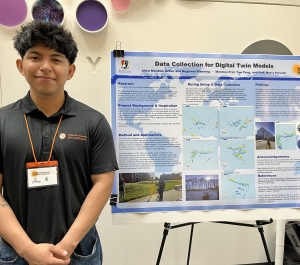
Experimenting Data Collections for Digital Twin Models for Urban Planning and Urban Design
Allen Mendez, Urban and Regional Planning
Buffalo State University
Faculty Mentor: Dr. Tao Tang
To create a scaled-three-dimensional (3D) digital model using ArcGIS Pro GIS software, data must be collected through a ground LiDAR or laser scanning system. In this project, our team developed a LiDAR system, consisting of a LiDAR scan head, a laptop, a Global Positioning System (GPS) for real-world coordinate data, and a portable power supply. This system was used to gather 3D point cloud datasets at two locations on campus: the courtyard of the Student Union and the Library. The goal of this project is to construct digital models of these buildings within the ArcGIS Pro environment with the ultimate aim to create a digital twin of the campus in providing a virtual representation of SUNY’s major urban campus for prospective students.
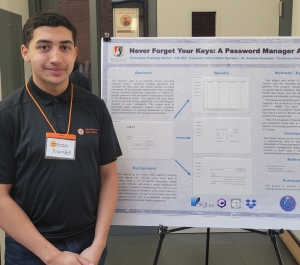
Never Forget Your Keys: A Password Manager App
Fransley Michel, Computer Information Systems
Buffalo State University
Faculty Mentor: Prof. Eric Nagel
This project’s goal is to promote secure password practices through the use of a password manager that facilitates the generation and storage of unique passwords. Despite the widespread use of advanced encryption algorithms, a user’s password is often the weakest link to their account’s security. This vulnerability can be mitigated by using a password that conforms to most requirements (8+ characters, 1+ numbers, special characters, capitalizations). However, such passwords are either difficult to remember, leading to insecure storage like on sticky notes, or are easy to remember but end up being vulnerable to dictionary attacks due to using common words. Password managers aim to solve both of these issues, by generating strong passwords and securely storing them in an encrypted file. Furthermore, the latest NIST standards encourage the use of passphrases, the use of multiple words together to create passwords that are longer and are significantly easier for people to remember. Through two algorithms included within the program, a password generator and a strength checker, the program aims to showcase ideal password creation while providing insightful feedback on potential passwords to enhance users' understanding of strong password practices. By presenting the advantages these tools provide in improving our password practices, we can bolster our digital security, protect our information from unauthorized use, and foster a safer environment online.
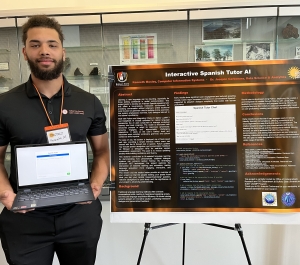
Spanish Speaking Confidence AI Tutor
Kenneth Mosley, Computer Information Systems
Buffalo State University
Faculty Mentor: Dr. Joaquin Carbonara
Learning a new language can be daunting, especially for those lacking confidence in verbal communication. This project seeks to develop an AI-driven Spanish-speaking tutor that offers a low-pressure, interactive environment for practicing conversation without judgment. Unlike traditional tools focused on grammar rules or multiplechoice exercises, this system emphasizes real-time, fluid dialogue tailored to the learner’s proficiency. Built with Python and integrating Ollama to deploy a LLaMA 3 model optimized for natural language processing, the AI uses LangChain to manage contextual memory and track progress. The model is fine-tuned with structured prompts to adapt its responses dynamically, ensuring engaging and appropriately challenging interactions. It starts at the user’s fluency level and introduces more complex vocabulary, grammar, and cultural context as skills improve. For ease of use, the system is deployed via a Flask-based web app, providing a simple interface where users can interact with the AI through text or speech. Future updates may include speech recognition and pronunciation feedback via Whisper or Deepgram APIs for real-time spoken conversation assessment. The goal is to reduce speaking anxiety while building confidence and fluency. This research contributes to AIassisted language learning by demonstrating how personalized, adaptive dialogue systems can enhance spoken fluency. By leveraging advanced NLP techniques, the project explores the intersection of machine learning and education, making language acquisition more engaging, interactive, and accessible.
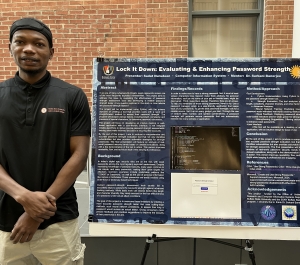
Lock It Down: Evaluating and Enhancing Password Strength
Sadat Nurudeen, Computer Information Systems
Buffalo State University
Faculty Mentor: Dr. Sarbani Banerjee
In an era of rising cybersecurity threats, weak passwords remain one of the most frequently exploited vulnerabilities. This project aims to address this issue by evaluating the effectiveness of password strength assessment tools and developing a reliable password strength tester. A key question explored in this study is: How reliable are password-strength testers? The project will be implemented using Python, with the primary objective of creating a tool that provides users with a quick and straightforward method to assess their password strength. The program will analyze various factors, including length, complexity, and the presence of special characters, to determine password robustness. Additionally, it will offer actionable recommendations for improving weak passwords. The project will focus on developing an intuitive desktop or web-based application with a user-friendly interface. It will integrate reliable algorithms to deliver precise password strength assessments, helping users make informed decisions about securing their accounts. By the end of this project, I aim to produce a comprehensive and accurate password strength evaluation tool that not only identifies vulnerabilities but also provides actionable strategies for stronger passwords. The final presentation will feature an analysis of real-world password security trends based on dataset evaluations, along with a live demonstration of the tool in action.
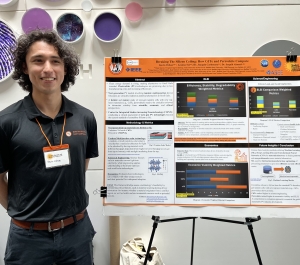
Breaking the Silicon Ceiling: How CdTe and Perovskite Compare
Kevin Ochoa, Mechanical Engineering Technology
Buffalo State University
Faculty Mentor: Dr. Saquib Ahmed
How does cadmium telluride (CdTe) and perovskite photovoltaics (PV) compare to traditional crystalline silicon (c-Si) in terms of efficiency, scalability, and stability? Due to concerns on climate change, the global demand for renewable energy has been rising every year. Researchers have been working on more efficient and costeffective solar technologies to meet these needs. While c-Si has been the industry standard, alternatives like CdTe and perovskite offer the potential for higher efficiency and easier manufacturing. This project focuses on recent developments of CdTe and perovskite photovoltaics. Basic research on specific fields includes trends in efficiency, scalability potential, and overall technological progress. A further analysis of economic viability and aspects of ethical, legal and social implications (ELSI) is also conducted. Cdte and perovskite PVs are then compared to c-Si as the baseline and ranked based on their performance in these areas. The study also explores how machine learning can further enhance next-generation PVs. The goal of this research is to assess how CdTe and perovskite photovoltaics have evolved in recent years and to determine whether they have a clear path to surpassing silicon in commercial solar applications.
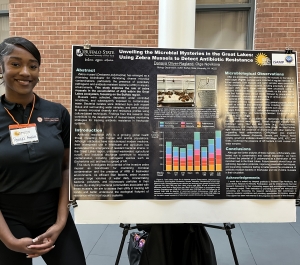
Zebra Mussels as Bioindicators of Antibiotic Resistance in the Great Lakes
Danaya Oliver-Ragland, Biology
Buffalo State University
Faculty Mentor: Dr. Olga Novikova
The zebra mussel (Dreissena polymorpha) is an invasive freshwater bivalve that has spread rapidly across North America, particularly in the Great Lakes, after its introduction from Eurasia in the late 1980s. Known for forming dense colonies on hard surfaces, it disrupts ecosystems, outcompetes native species, and clogs water intake systems. Despite its negative impacts, zebra mussels serve as bioindicators, accumulating contaminants, including heavy metals, pollutants, and microbial communities, due to their high filtration capacity. Recently, zebra mussels have been studied as bioindicators of antibiotic resistance, a growing concern in freshwater ecosystems due to agricultural runoff, wastewater discharge, and pharmaceutical contamination. By filtering large volumes of water, they accumulate antibioticresistant bacteria (ARB) and antibiotic resistance genes (ARGs), making them valuable for monitoring microbial resistance. Compared to other bioindicators, zebra mussels are widely distributed, easy to collect, and effectively reflect environmental microbial shifts. Our research project explores the use of zebra mussels in the Great Lakes as bioindicators of antibiotic resistance by sampling mussel populations, isolating bacterial communities from their tissues, and using culture-dependent methods with CHROMagar and other selective media to identify antibiotic-resistant bacteria. This approach enables the selective isolation and characterization of ARB, providing insights into the prevalence of resistant strains and their potential sources. By integrating environmental microbiology and culture-based analysis, our study aims to establish zebra mussels as a cost-effective tool for tracking antibiotic resistance, supporting efforts to monitor and mitigate microbial threats in freshwater ecosystems and contributing to improved environmental management and public health strategies.
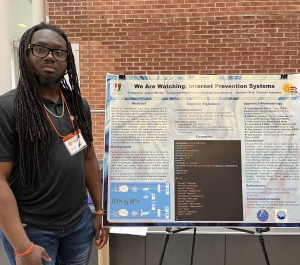
We are Watching: Intrusion Prevention Systems
Jamie Olivier, Computer Information Systems
Buffalo State University
Faculty Mentor: Prof. Charles Arbutina
Millions of cyberattacks occur daily, threatening the security of private networks and putting sensitive data at risk. To help protect against these threats, organizations use Intrusion Detection Systems (IDS) to monitor network traffic and identify suspicious activity. IDS can detect threats using two main methods: signature-based detection, which recognizes known attack patterns, and anomaly-based detection, which identifies unusual behavior. However, while IDS alerts administrators to potential breaches, it does not take action to stop them. To address this limitation, Intrusion Prevention Systems (IPS) expand on IDS by not only detecting threats but also blocking or mitigating them in real time. IPS actively analyzes traffic and can prevent attacks before they cause harm.
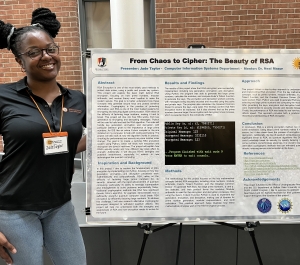
From Chaos to Cipher: The Beauty of RSA
Jade Taylor, Computer Information Systems
Buffalo State University
Faculty Mentor: Dr. Sarbani Banerjee
RSA Encryption is one of the most widely used methods to protect data online, using a public and private key system. This project will explore the basic math behind RSA encryption, focusing on how prime numbers, modular arithmetic, and number theory work together to make the system secure. The goal is to better understand how these concepts help generate secure keys and protect sensitive information. Cryptography is the practice of protecting information, and RSA is one of the most trusted systems for encrypting and securing digital communication. RSA relies on the difficulty of factoring large numbers, making it hard to break. This project will dive into how RSA works, from key generation to encrypting and decrypting messages. Python will be used to build and test the RSA algorithm. The code will handle key generation, encryption, and decryption, with particular attention given to the importance of large prime numbers. An IDE like an online Python compiler or the one installed on my computer, to help with coding and testing. The project will also look at how the algorithm works in practice, checking its performance and security as prime number sizes change. The goal is to create a working RSA encryption system using Python, which will show how encryption and decryption are done in real-time. The project will explain how RSA’s security works and how different key sizes affect its strength. Additionally, it will discuss RSA's strengths and potential weaknesses, especially in relation to new technologies like quantum computing.
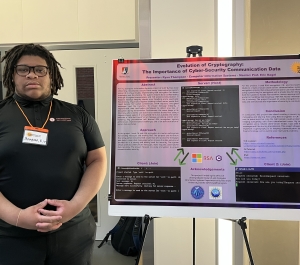
Evolution of Cryptography: The Importance of Cyber-Security Communication Data
Ryan Thompson, Computer Information Systems
Buffalo State University
Faculty Mentor: Prof. Eric Nagel
For my Computer Information Systems project at SUNY Buffalo State University, I developed a secure client-server communication system using C# in Visual Studio, implementing RSA encryption for secure messaging and file sharing. The system ensures data confidentiality through encrypted transmissions and TCP socket communication. It features message integrity checks, error handling, and a searchable file directory. My project requires creating a client-server model that could handle TCP socket connections, HTTP requests, encrypted messages, and file transfers. To ensure message integrity, I implemented data verification techniques to detect any loss or disruption during transmission. Furthermore, the server keeps a file directory where clients can search and retrieve shared files using a keyword-based system. If a requested file is not available, the server provides a "404 Not Found" error message, providing correct error handling. My presentation will discuss RSA encryption, system architecture, implementation challenges, and a live demonstration of secure data exchange.
2024 LSAMP SCHOLARS

The Video Game Dilemma
David Akanbi, Computer Information Systems
Buffalo State University
Faculty Mentor: Dr. Sarbani Banerjee
Do the reasons for playing games (e.g., entertainment, challenge, social interaction) correlate with the popularity of certain genres or platforms? Can the demographic profile of video game players predict the success of future video games? Video games have been a staple in entertainment for decades, and finding out about the future of gaming would be essential in advancing our current forms of entertainment. In this research, the similarities and differences between two different data sets will be explored. To address this question, the analysis will leverage Python through both Google Collaboratory and Anaconda Notebook to properly sort and find the data needed in particular to select specific information. Also, using Kaggle will supply this analysis with the multiple datasets needed to investigate the question of this project. Utilizing advanced data analysis and visualization libraries such as Pandas, NumPy, Altair, and Matplotlib the research will analyze the specifics of decades' worth of game ratings, developer reputations, and consumer feedback. In this process, finding how genres affect the rating of a game, how many people rated the games, how the ratings from the consumers and the critics differ, and predicting the future of gaming through past events. This project aims to conduct a thorough analysis of the complex dynamics of the video game industry by looking at the relationships between user preferences, demographic traits, game attributes, and industry trends. While comparing them to people's favorite games, what they play the most, and their age.
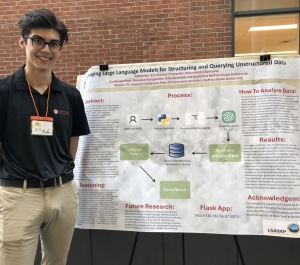
Leveraging Large Language Models for Structuring and Querying Unstructured Data
Eric Barton, Computer Information Systems
Buffalo State University
Faculty Mentor: Dr. Joaquin Carbonara
This research project delves into the application of Large Language Models (LLMs) to efficiently structure unstructured data and facilitate information retrieval through natural language queries. The study focuses on harnessing the power of LLMs to enhance the comprehension of web data by leveraging their contextual understanding and language processing capabilities. The project adopts a practical approach by utilizing Python and the OpenAI API to develop a Flask application. The application is designed to scrape data from the Buffalo State webpage, and using LLMs, transform the unstructured information into structured formats. This innovative approach enables the comparison of different structuring techniques, shedding light on how LLMs interpret and organize data. Key components of the research include the implementation of a systematic process that integrates the OpenAI API key to fetch data from a specified webpage URL. The data is then processed and structured in various ways to facilitate meaningful comparisons of results. The goal is to discern the nuances in how LLMs read and interpret information, providing insights into their strengths and limitations in handling diverse types of data. By employing natural language queries, the research assesses the ability of LLMs to comprehend and respond to user-generated questions based on the structured data. This methodology not only contributes to the understanding of LLMs' natural language processing capabilities but also explores the potential of these models in creating user-friendly interfaces for information retrieval. The findings from this research contribute to the growing body of knowledge on the practical applications of LLMs in structuring and querying unstructured data. The developed Flask application serves as a valuable tool for testing and evaluating LLMs in real-world scenarios, offering a foundation for future advancements in natural language understanding and data processing.
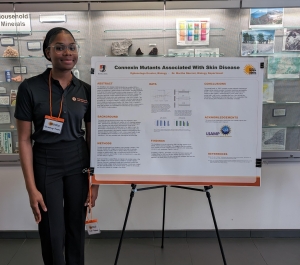
Connexin Mutants Associated With Skin Disease
Oghenetega Eruotor, Biology
Buffalo State University
Faculty Mentor: Dr. Martha Skerrett
The hereditary skin disease erythrokeratodermia variabilis (EKV) is characterized by transient patches of red, thickened skin. This disease is caused by mutations in genes critical for skin function, including mutations in the gene that codes for a gap junction protein known as Cx30,3. This research is focused on better understanding the molecular changes that take place because of these mutations with focus on two missense mutations that cause animo acid substitutions in the Cx30.3 protein. The first mutation of interest is S20Y which results in tyrosine replacing serine at position 20. The second mutation of interest in ME0L which results in leucine replacing methionine at position 190. Bioinformatics was used to review the location and properties of altered amino acids Since Cx30.3 i5 known to form gap junctions, the Xenopus oocyte expression system is being used to study gap junctions and associated hemichannels that are formed by Cx30.3 and the mutant proteins.
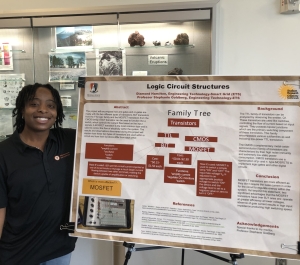
Logic Circuit Structures
Diamond Hamilton, Engineering Technology
Buffalo State University
Faculty Mentor: Dr. Stephanie Goldberg
For my research, I would like to dive deeper into understanding the inner workings of logic circuits as well as their packaging. I hope that the audience finds interest in the electrical and mechanical aspects of the project, seeing how the different gates alter the voltage and current throughout the system. Specifically, this project will encompass how and-gates and or-gates are made with the two different types of transistors, BJT transistors from the TTL logic family and the MOSFET transistors from the CMOS family. A BJT transistor can be used to function like a switch, which controls the current flow based on the input signals. A MOSFET transistor is the most common type and is used to control the flow of electricity within the system. The results and observations discovered during this project will explain how these two types of transistors are used within a circuit and how their functions differ from each other.

Analyzing Suicide Rates Amongst Men
Jayden Heath, Computer Information Systems
Buffalo State University
Faculty Mentor: Dr. Sarbani Banerjee
This research project attempts to analyze the complex issue of suicide rates among men, aiming to uncover patterns and potential factors contributing to this phenomenon. The questions driving this investigation are as follows: What mental health conditions or disorders are most associated with suicide? Is there a correlation between substance abuse and suicide rates? What is the overall trend in suicide rates over the years covered by the dataset? What demographic groups are most affected by suicide? To answer these questions, background information regarding the prevalence of suicide, particularly among males is provided. With data collected from countries all over the world, the effects of mental health over the years and its correlation to substance abuse and disorders will be displayed. The methodology involves Python programming using Google Colab and utilizing datasets sourced from the source Kaggle. Matplotlib is a comprehensive library for creating visualizations in Python and Seaborn is a Python visualization library based on Matplotlib that will be used in this project. Pandas is a popular Python library and will be used to manipulate and structure the data. All three of these libraries integrate well with each other allowing the best statistical visualization. By employing exploratory data analysis and visualization tools, this research project aims to identify correlations and patterns within the data. Preliminary findings reveal geographical variations in suicide rates among men, along with potential correlations with economic indicators and mental health resources availability. These insights provide a foundation for further analysis and exploration.
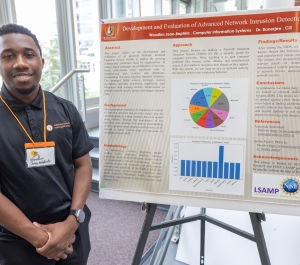
Development and Evaluation of Advanced Network Intrusion Detection System
Woodlen Jean-Baptiste, Computer Information Systems
Buffalo State University
Faculty Mentor: Dr. Sarbani Banerjee
This project centers on the development and evaluation of an advanced Network Intrusion Detection System (NIDS) to address the growing cybersecurity challenges faced by organizations. In today's digital landscape, the proliferation of network-based cyber-attacks poses significant risks to organizational data, systems, and operations, necessitating innovative intrusion detection solutions. The proposed NIDS solution leverages custom algorithms, real-time monitoring capabilities, and integration with existing security infrastructure to enhance network security posture and mitigate security risks. The methodology involves integrating packet sniffers, traffic analyzers, machine learning algorithms, and rule-based detection engines within the organization's network infrastructure. Through extensive testing and evaluation, the performance, accuracy, and scalability of the NIDS solution are assessed under various network conditions and attack scenarios. Preliminary results demonstrate promising improvements in detection accuracy and response time. The anticipated outcome of this project is the development of a robust NIDS solution capable of proactively detecting, responding to, and mitigating network-based cyber threats. By strengthening organizational cybersecurity defenses, the NIDS solution aims to safeguard critical assets and ensure business continuity in the face of evolving cyber threats. In conclusion, this project represents a significant step towards enhancing organizational cybersecurity in today's complex threat landscape. By leveraging advanced intrusion detection techniques and real-time monitoring capabilities, the developed NIDS solution aims to empower organizations with the tools and capabilities needed to effectively combat cyber threats and protect sensitive data and assets.
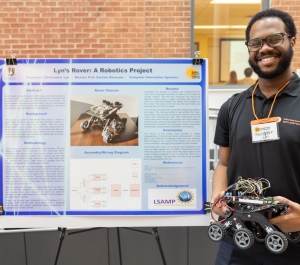
Lyn’s Rover - Robotics Project
Christopher Lyn, Computer Information Systems
Buffalo State University
Faculty Mentor: Dr. Gang Hu
As the world constantly evolves, technology must rapidly advance to keep up with it. To adapt, technologists must find ways they can advance their knowledge and understanding of technology. This project seeks to deepen the understanding of serial communication and robotics by building a rover and programming it to be remote controlled through the Raspberry Pi and Arduino. This project is inspired by the NASA rover project, in which a rover called Perseverance was built and launched to Mars in 2020 to explore and collect data for NASA . What this rover project seeks to do is evaluate and broaden the understanding of serial communication with a small rover and learn how data can be bounced back between the rover’s Arduino and the computer. Additionally, this project will help improve programming skills and open doors for future robotics projects. The equipment needed for this project includes an Arduino and a Raspberry Pi to program the robot. A Bogie Runt Rover assembly kit is used to build the shell of the robot. Electrical motors connected to an h-bridge and a battery enable control over all the wheels on the rover. The specific skills needed to complete this project are knowledge of circuitry, soldering, wiring, and knowledge of both python and Arduino code. The expected result of this project is a rover that can be remote controlled to move around the room. Communication will be evaluated by trying to control the robot’s movements, meaning whether turns left or right and accelerates or decelerates.
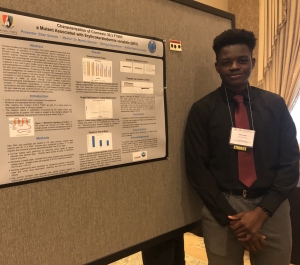
Characterization of Connexin 30.3 F189Y: a Mutant Associated with Erythrokeratodermia variabilis (EKV)
Ettan Saiwala, Biology
Buffalo State University
Faculty Mentor: Dr. Martha Skerrett
Connexin proteins are highly expressed in the human epidermis where they form gap junctions. A connexon is a transmembrane channel composed of six connexin subunits. Characteristically, two connexons form an intercellular gap junction channel. However, connexons can also function as transmembrane channels both physiologically and pathologically. Connexin30.3 (Cx30.3) is one of several connexins expressed in the stratum granulosum layer of the skin. Point mutations in the Cx30.3 gene (GJB4) cause a rare skin disease categorized as erythrokeratodermia variabilis (EKV) involving areas of erythema (reddening of the skin) and hyperkeratosis (thickening of the outer layer of skin). Using site-directed mutagenesis we created the Cx30.3 mutant F189Y associated with EKV and expressed this mutant in Xenopus oocytes. F189Y-injected cells died quickly compared to Cx30.3-injected cells. They did not however appear to be more permeable to water, as shown through oocyte bursting experiments. Electrophysiological characterization using whole-cell voltage clamp revealed an increase in membrane conductance in oocytes expressing F189Y. This conductance was likely mediated by F189Y as it was blocked by divalent cations. We also observed gap junctions formed by Cx30.3 and Cx30.3 F189Y in paired oocytes and will discuss the properties of these junctions.
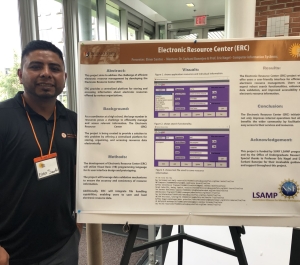
Electronic Resource Center (ERC)
Elmer Santos, Computer Information Systems
Buffalo State University
Faculty Mentor: Dr. Sarbani Banerjee
This project aims to address the challenge of efficient electronic resource management by developing the Electronic Resource Center (ERC). ERC provides a centralized platform for storing and accessing information about electronic resources offered by various organizations. By integrating user-friendly interface, robust search functionalities, and security measures, LERC promises to streamline resource management processes and enhance accessibility for users across different domains. The large number of resources poses a challenge to efficiently manage and access relevant information. The Electronic Resource Center (ERC) project is being created to provide a solution to this problem by offering a centralized platform for storing, organizing, and accessing resources data electronically. This project is essential to address the growing need for streamlined resource management in the school, this application can also be used by other organizations. The development of Lafayette Electronic Resource Center (LERC) will utilize Visual Basic (VB) programming language for its user interface design and prototyping. The project will leverage data validation mechanisms to ensure the accuracy and consistency of resource information. Additionally, ERC will integrate file handling capabilities, enabling users to save and load electronic resource data for enhanced data persistence and portability. Upon completion, the Electronic Resource Center (ERC) project will offer users a user-friendly interface for efficient electronic resource management. Users can expect robust search functionalities, enhanced data validation, and improved accessibility to electronic resource information. By providing a centralized platform for resource management, ERC aims to streamline processes and empower users across various domains.
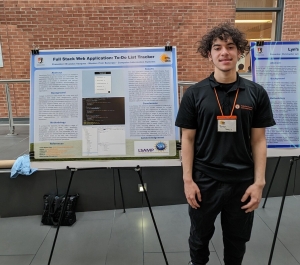
Full Stack Web Application: To-Do Tracker
Brandon Vasquez, Computer Information Systems
Buffalo State University
Faculty Mentor: Dr. Sarbani Banerjee
The primary focus of this research project is to develop a comprehensive to-do list tracker as a full-stack web application, encompassing both front and back ends. The main goal is to create a highly beneficial tool tailored specifically for college students, acknowledging the crucial role of time management and task prioritization in academic and real-world contexts. The aim is to provide a robust solution that enhances productivity and organization. To address the need for an efficient task management system, a variety of technologies will be leveraged, including HTML, CSS, JavaScript, SQL (Structured Query Language), EJS (Embedded JavaScript), Git, and potentially APIs and security measures. The front end will utilize HTML, CSS and EJS, while the back end will rely on PostgreSQL. The server-side will be implemented using JavaScript, Node.js, and frameworks like Express.js from Node Package Manager (NPM). Development will be facilitated by Visual Studio Code as the IDE, with GitHub/Git managing version control and repository management, and pgAdmin handling database operations. Expected outcomes of this project will primarily include a fully functional full-stack web application where users can create accounts, log in, and efficiently manage their to-do lists. Users will have the capability to create, edit, delete, and prioritize tasks, empowering them to effectively organize their responsibilities. To ensure user privacy and data security, secure user authentication mechanisms will be implemented.
2023 LSAMP SCHOLARS

Antibacterial Properties of the Pyrazine-Piperazine Derivatives
Jadelene Adams, Biology
Buffalo State University
Faculty Mentor: Dr. Olga Novikova
With the rise of the bacterial resistance to antibiotics in the population, there has been a great effort to address this global health issue by innovating new antibacterial compounds that can combat the resistance with precisive bacterial targets. This current study aims to evaluate the potency of the synthesized compounds against gram-positive bacteria, Staphylococcus aureus, and gram-negative bacteria, Escherichia coli. The core of the compound, pyrazine-piperazine (PYZ_PY), was synthesized using the Buchwald Hartwig Amination reaction. The compound was further diversified at the N-terminus by coupling with different heterocyclic carboxylic acids. The MIC (Minimum Inhibitory Concentration) of the resultant analogs was measured by high-throughput assay against bacteria, S. aureus, and E. coli, using standard protocol measuring optical density (OD) on the plate reader. For each trial, antibiotic chloramphenicol was used as a control treatment, while untreated bacterial cultures were used as the negative control. The MIC experiments were followed by plating of the cultures and direct colony count to verify OD observations. Additionally, we performed a Kirby Bauer assay following established standard protocol. Our preliminary data suggest that at least one of the compounds, the derivative furoic acid PYZ_PY, exhibits potential antibacterial qualities against the gram-positive S. aureus. In the future, the experimental compounds will be demethylated at the hydroxyl ends and tested against S. aureus and E. coli to determine their effectiveness.
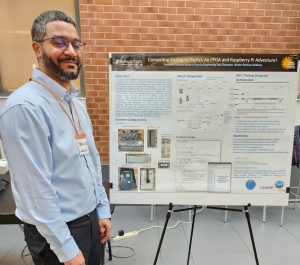
Converting Analog to Digital: An FPGA and Raspberry Pi Adventure!
Lawrence Bailey, Engineering Technology
Buffalo State University
Faculty Mentor: Dr. Stephanie Goldberg
The goal of this research project is to control an Analog to Digital Converter (ADC), which is an important electronic device that converts real-world sensor data, such as temperature and pressure, into digital form, where it can be processed and displayed. The ADC will be controlled over a Serial Peripheral Interface (SPI) using both a Field Programmable Gate Array (FPGA) circuit and a Raspberry Pi single-chip computer. Analog test signals will be fed to the ADC, and the digitized values will be sent to the controller using the SPI protocol. The controller will then display the original analog information. This project will involve designing the FPGA circuit and programming the Raspberry Pi using Python programming language. The FPGA on an Altera DE1 Development and Education Board will be used and programmed by the Quartus II software tool. The MCP3004 Integrated Circuit (IC) chip will be used as the 10-bit ADC to convert the analog signals to digital signals. The expected results will be compared to the actual results and analyzed using test equipment such as an oscilloscope and digital voltmeter.
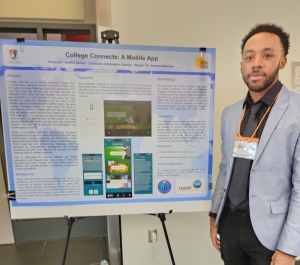
College Connect App
Khallid Barber, Computer Information Systems
Buffalo State University
Faculty Mentor: Dr. Sarbani Banerjee
College Connects is a mobile application that connects users with local service providers, who are mostly college students, for lawn care and snow shoveling. Users can input their address, zip code and the date of service. The app will provide a list of local service providers. Once the user selects a provider, the app will give them a quote based on the service needs. By using College Connects App, users can save time and money in searching for service providers and can rest assured that they will be getting quality service. The main goal is to develop an App compatible on both Android and iOS smartphones so that clients can easily upload required information and get same day quotes for their service. This App will be designed and debugged using Flutter open-source UI. Flutter is a mobile application development framework developed by Google that allows developers to build high-performance, visually appealing, and feature-rich mobile applications for multiple platforms using a single codebase. Flutter uses the Dart programming language, which is designed for cross-platform development and enables developers to write code that can be compiled to native machine code for multiple platforms. The Dart language is well-suited for building scalable and flexible applications with features that make it easy to work with asynchronous code. Overall, Dart and Flutter provide an efficient and powerful solution for building cross-platform mobile applications.
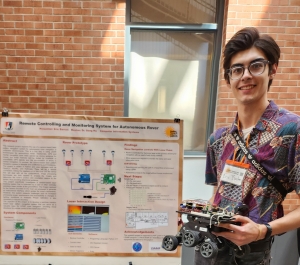
Walking the Rover
Eric Barton, Computer Information Systems
Buffalo State University
Faculty Mentor: Dr. Gang Hu
This research project aims to develop a more intuitive and efficient control system for the Rover. In prior research, a remote-control system with a graphical user interface has been implemented successfully. Current research will focus on implementing a laser-pointer-based control system using computer vision techniques. Specifically, the project proposes to use the OpenCV library to detect the laser point and move the Rover accordingly. A camera mounted on the Rover will be used to detect the laser-point and navigate to a given destination. The image processing pipeline involves converting the video frame to the HSV color space and applying a color filter to extract the laser-point. To reduce noise, the mask, frame, and HSV layers are compared and will look for the color filter on these video frames. The coordinates of the laser point will be saved in an array and used to create gestures such as spin or reverse. The coordinates are taken from the laser point and used to control where and how the Rover moves. Python packages such as OpenCV, Numpy, and Pyfirmata will be utilized. The proposed laser-pointer-based control system offers a more natural and streamlined interface compared to traditional controls. With the laser-point controls it resembles walking a well-trained dog on a leash. The laser-pointer-based control system serves as an introduction to controlling the Rover using computer vision, with the goal of achieving fully autonomous travel.
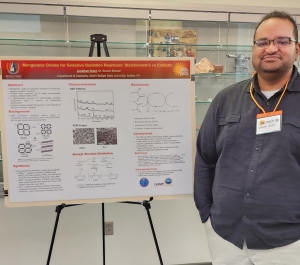
Manganese Oxides for Selective Oxidation Reactions: Stoichiometric vs Catalytic
Jonathan Grant, Chemistry
Buffalo State University
Faculty Mentor: Dr. Sourav Biswas
Manganese oxides are prevalent materials for catalyzing selective oxidation reactions, stemming from their affordability and performance. The catalytic properties of manganese oxides are strongly related to the easily tunable redox properties due to easily exchangeable multiple oxidation states of Mn and their oxygen reducing ability. However, to obtain reasonable performance, a stoichiometric (could range anywhere from 2 times to 5 times the amount of the reactants) amount of commercially available manganese oxides is often required for selective oxidation reactions. In this study, we synthesize different structural forms of manganese oxides by sol-gel redox process and identify the potential catalytic Mn oxide materials for selective oxidation reactions. Our major focus is on OMS (octahedral molecular sieves) series of manganese oxides, which have been known to be prepared in various structural forms with tunable physicochemical properties. Selective oxidation of benzoyl alcohol to benzaldehyde is used as a probe reaction with potential expansion to oxidative C-H functionalization.
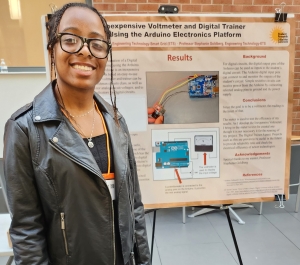
Inexpensive Voltmeter and Digital Trainer Using the Arduino Electronics Platform
Diamond Hamilton, Engineering Technology
Buffalo State University
Faculty Mentor: Dr. Stephanie Goldberg
This research involves the implementation of a Digital Voltmeter and Digital Circuit Trainer using the Arduino Microcontroller system. The Arduino is an inexpensive open-source electronics platform based on easy-to-use hardware and software. The voltmeter and trainer can be used by students in the freshman circuits class, as well as by home hobbyists, to monitor analog circuit voltages, and to provide test inputs and indicators for digital circuits. To obtain a voltage reading of a circuit node, the node can be connected by wire to one of the Arduino Analog input channels. The Arduino’s analog sensor is able to convert the given voltage into a digital value that is comprehensive to the Arduino’s microcontroller. The digital value can then be processed and displayed by the microcontroller. The Arduino is connected to a PC and so the values obtained from the Analog readings can be viewed on the PC monitor. The system will be designed to have clear well-documented information sent to the PC monitor. For digital circuits, the Arduino Digital Write and Digital Read functions can be used to test the circuits. The digital output pins of the Arduino can be used as inputs to the student’s digital circuit. The Arduino digital input pins can connect to and monitor the outputs of the student’s circuit so that students can compare their actual outputs with expected results.

Application of Cyber Physical Systems in Automation Control
Gedion Melesse, Engineering Technology
Buffalo State University
Faculty Mentor: Dr. Ilya Grinberg
The 4th industrial revolution, also known as Industrie 4.0, is being promoted by the newly emerging research in the field of cyber physical manufacturing systems, which integrates computer science with manufacturing science and technology. Cyber-Physical Systems (CPS) generally focuses on the integration of the physical world with cyberspace. It is the incorporation of physical components with data acquisition, control, and communication in an automation environment. At present time, CPS is the point of interest for numerous academia, governmental and industrial sectors. Empowered by the recent development in the Internet of Things and cloud computing technologies, CPS are evolving as a major contributor during and post the product manufacturing process. Cyber products now have a virtual space in addition to their real physical space. A product's virtual space is a digital duplicate that is connected to it so that manufacturers and their consumers may better manufacture, supervise, maintain, and utilize it over the course of its life cycles. Although the development of production technologies and CPS has undoubtedly benefited manufacturers, they have also had to address the risks that these interconnected systems pose to their operations. The manufacturing industry as a whole is well aware of this threat, and many manufacturers claim that cyber security is an essential part of their automated operations. This research project seeks to provide the findings from studies on the use of cyber physical systems in automation and the creation of such systems for intelligent manufacturing. The ever-growing need for implementation of cybersecurity and other protective systems will also be discussed. The cyber physical systems architecture and its application in manufacturing will also be explored in this project. This project will also emphasize the importance of cloud computing and the Internet of Things in industrial manufacturing and factory automation. The final product will consist of a paper and brief powerpoint presentation. The findings of the research will be thoroughly discussed in the paper and the presentation will briefly cover the results.
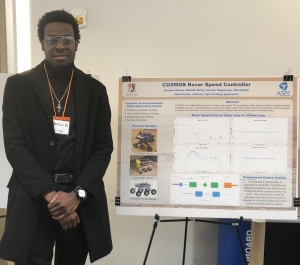
Research Aspect of COSMOS III
Makaih Rivas, Engineering Technology
Buffalo State University
Faculty Mentor: Dr. Ilya Grinberg
DC motor control is a critical aspect of many industrial and automation systems. The ability to precisely control the speed, torque, and direction of a DC motor is essential for a wide range of applications, from robotics and manufacturing to automotive and aerospace systems. DC motors are widely used due to their high efficiency, reliability, and ease of control. However, controlling a DC motor can be complex, as it requires precise control of the voltage, current, and position of the rotor. In recent years, advances in power electronics, microprocessors, and control algorithms have led to significant improvements in DC motor control systems. Various control techniques such as PID control, fuzzy logic control, and model predictive control have been used to improve the performance of DC motor control systems. Moreover, the development of digital signal processing and field-programmable gate array (FPGA) technology has enabled the implementation of sophisticated control algorithms in real time. This literary paper/presentation provides an overview of DC motor control, including the principles of operation, different types of DC motors, and various control techniques. The advantages and limitations of different control strategies are discussed, along with the factors that affect the performance of DC motor control systems. Finally, recent developments in DC motor control systems are presented, highlighting the challenges and future directions for research in this field.
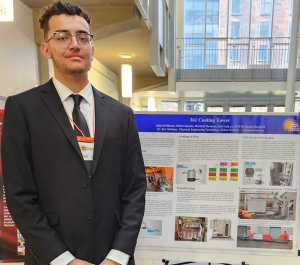
Different Control Strategies for Variable Frequency Drives
Joshua Van Lew, Engineering Technology
Buffalo State University
Faculty Mentor: Dr. Ilya Grinberg
This research project deals with scholarly literature reviews of different control strategies for variable frequency drives (VFD). The goal is to select state-of the art scholarly papers describing various control methods and how they influence VFD performance. Currently I am familiar with four control strategies, such as voltage-frequency control without an encoder, with an encoder, closed-loop vector control, and open-loop vector control. In-depth investigation of these methods as well as other methods involving artificial intelligence (AI) and machine learning (ML), will allow to identify optimal control strategies for VFD and make recommendations for users how to select most appropriate control technique for their specific applications.

